Milky Way Galaxy Simulation
A Distant View of the Milky Way: A Work of Imagination
Remote photographs of the Milky Way Galaxy in all its splendor are a common sight for astronomy enthusiasts. However, it is important to remember that these images are not real, they are works of art or scientific modeling.
Why Is It Not Real?
- Location: We are located in the Milky Way, about 27,000 light years away. This means we would have to travel an enormous distance to get outside the galaxy and photograph it. With today's technology, such a huge journey is not possible.
- Speed of Light Even our fastest spacecraft travel well below the speed of light. Therefore, to reach the outside of the galaxy and return to take a picture would require a journey that would take thousands of years.
- Galactic Dust: The central regions of the Milky Way are covered by dense clouds of dust that obscure our view. This dust prevents the galaxy from being seen clearly from a distance.
How are these images created?
Remote images of the Milky Way are based on observations of other spiral galaxies. By studying galaxies with similar structures, astronomers make inferences about the overall shape and structure of the Milky Way. This information is used by artists and scientists to create visual models of what the Milky Way might look like.
Remote photographs of the Milky Way are artistic interpretations based on scientific data. While these images inspire us about the size and beauty of our galaxy, it is important to know that they are not a real photograph. Perhaps one day, thanks to future technologies, we will be able to go outside the Milky Way and take a real photo of it. But for now, let's let these images feed our imagination and curiosity.
General Information on the 50 Most Known Stars
Stars, the sparkling jewels of the sky, are a fascinating part of the universe, each with their own unique characteristics. Some are close to us, while others are at mind-boggling distances. Some stand out with their dazzling brilliance, while others shine more calmly and modestly. Get ready to discover some of the stars below, which we won't name, but only list their characteristics. Their temperatures, sizes, colors and other characteristics will once again reveal just how diverse and amazing the universe is.
Sun
Type of star: Yellow dwarf (G2V)
Apparent brightness: The brightest object in the daytime sky, it is not safe to look at with the naked eye. It is a star at -26.74 gal.
Remoteness: It is on average 149.6 million kilometers (1 Astronomical Unit) from Earth.
Color and warmth: It is yellow in color. Its surface temperature is about 5778 K (about 5505 °C).
Size (radius and mass): It has about 109 times the radius and 333,000 times the mass of Earth.
Age: It is about 4.6 billion years old.
Constellation: The Sun is not part of a constellation, but it appears to pass through the constellations of the Zodiac throughout the year.
Features:
- It lies at the center of the Solar System and orbits all the planets, asteroids, comets and other celestial bodies.
- In its core, nuclear fusion reactions take place, where hydrogen turns into helium. The energy released by these reactions makes the Sun shine and radiate heat.
- The Sun's magnetic activity causes events such as sunspots, solar flares and coronal mass ejections.
Interesting information:
- The sun is the source of life on Earth. It enables plants to photosynthesize and therefore produce food.
- The Sun's light takes about 8 minutes to reach the Earth.
- The Sun is just one of billions of stars in the Milky Way.
- The Sun is about halfway through its lifetime and in about 5 billion years it will expand into a red giant star and eventually end its life as a white dwarf.

Proxima Centauri
Type of star: Red dwarf (M5.5Ve)
Apparent brightness: It cannot be seen with the naked eye, but can be observed with a telescope. It is an 11th magnitude star.
Remoteness: It is located 4.2465 light years from our solar system.
Color and warmth: It is red in color. Its surface temperature is about 3042 K (about 2769 °C).
Size (radius and mass): Güneş’in yaklaşık %14’ü kadar yarıçapa (%12.5 kütle) sahiptir.
Age: It is about 4.85 billion years old.
Constellation: It is located in the constellation Centaurus.
Features:
- It is the closest star to the Sun.
- It is part of the triple star system Alpha Centauri.
- It has been confirmed to have at least two planets.
- It is a star with sudden changes in brightness.
Interesting information:
- Its Latin name means "the star closest to Centaurus".
- It was discovered in 1915 by Robert Innes.
- Its planet, Proxima Centauri b, is in the habitable zone and has a mass similar to Earth.

Milky Way Galaxy - Sirius
Type of star: Anacole star (A1V)
Apparent brightness: It is the brightest star in the night sky, easily visible to the naked eye. It is a -1.47 quadrillion star.
Remoteness: It lies 8.6 light years from our solar system.
Color and warmth: It is white in color. Its surface temperature is about 9940 K (about 9667 °C).
Size (radius and mass): It has about 1.71 times the radius (2.02 times the mass) of the Sun.
Age: It is about 250 million years old.
Constellation: It is in the constellation of the Big Dog (Canis Major).
Features:
- It is a double star system. It consists of two stars, Sirius A and Sirius B.
- Sirius B is a white dwarf.
- Sirius A is 25 times brighter than the Sun.
Interesting information:
- In ancient Egypt, it was used to determine the time of flooding of the Nile River.
- In Greek mythology, it is depicted as Orion's dog.
- It is the only star mentioned in the Quran (the star Shi'ra).
- Also known as the "White Star".
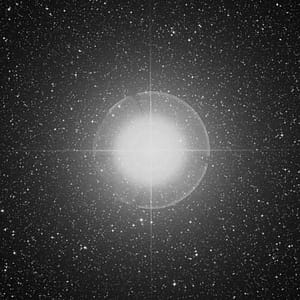
Milky Way Galaxy - Altair
Type of star: Anacole star (A7V)
Apparent brightness: It is the 12th brightest star in the night sky, easily visible to the naked eye. It is a 0.77 quadrillion star.
Remoteness: It is located 16.7 light years from our solar system.
Color and warmth: It is white in color. Its surface temperature is about 7550 K (about 7277 °C).
Size (radius and mass): It has about 1.8 times the radius (1.79 times the mass) of the Sun.
Age: It is about 1 billion years old.
Constellation: It is located in the constellation of the Eagle (Aquila).
Features:
- It is a fast-rotating star. It completes its rotation in about 10 hours. Because of this fast rotation, it has a bulging shape at the equator and a flattened shape at the poles.
- It is one of the three bright stars that make up the Summer Triangle (the others are Vega and Deneb).
Interesting information:
- It is derived from the Arabic word "al-tair", which means "flying eagle".
- "Cattle herder" in Chinese mythology and, together with the star Vega, is part of the legend of the "Weaver Girl".
- In the Star Trek universe, Altair is home to a planetary system inhabited by many different races.

Milky Way Galaxy - Vega
Type of star: Anacole star (A0Va)
Apparent brightness: It is the 5th brightest star in the night sky, easily visible to the naked eye. It is a 0.03 quadrant star.
Remoteness: It is located 25.04 light years from our solar system.
Color and warmth: It is white in color. Its surface temperature is about 9602 K (about 9329 °C).
Size (radius and mass): It has about 2.8 times the radius (2.135 times the mass) of the Sun.
Age: It is about 455 million years old.
Constellation: It is in the constellation of the instrument (Lyra).
Features:
- It is a fast-rotating star and therefore bulges at the equator and flattens at the poles.
- It is surrounded by a dust disk. This disk could be a sign of planet formation.
- It is one of the three bright stars that make up the Summer Triangle (the others being Altair and Deneb).
Interesting information:
- It is derived from the Arabic phrase "al-nasr al-waki", meaning "the falling eagle" or "the vulture".
- In Chinese mythology, she is known as the "Weaver Girl" and, together with the star Altair, the "Cattle Herder" is part of the legend.
- In 1850, Vega became the first star to be photographed.
- It is a bright star that can be seen overhead during the summer months in the northern hemisphere.
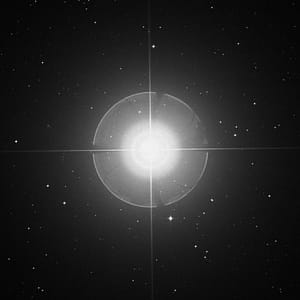
Milky Way Galaxy - Fomalhaut
Type of star: Anacole star (A3V)
Apparent brightness: It is the 18th brightest star in the night sky, easily visible to the naked eye. It is a 1.16 quadrillion star.
Remoteness: It is located 25.13 light years from our solar system.
Color and warmth: It is white in color. Its surface temperature is about 8590 K (about 8317 °C).
Size (radius and mass): It has about 1.84 times the radius (1.92 times the mass) of the Sun.
Age: It is about 440 million years old.
Constellation: It is in the constellation Southfish (Piscis Austrinus).
Features:
- It is surrounded by a large dust disk. This disk could be a sign of planet formation.
- An exoplanet called Fomalhaut b has been discovered. However, the existence of this planet is still controversial.
- "Also known as the Autumn Star.
Interesting information:
- It is derived from the Arabic word "fum al-hūt" meaning "mouth of the fish".
- In Persian mythology, it is considered the "Fourth Royal Star".
- In some cultures it is associated with fertility and abundance.
- It was observed by the James Webb Space Telescope, which captured the complex structure of the dust disk in detail.
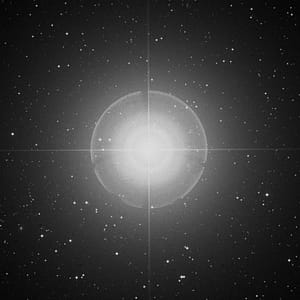
Milky Way Galaxy - Pollux
Type of star: Orange giant star (K0IIIb)
Apparent brightness: It is the 17th brightest star in the night sky, easily visible to the naked eye. It is a 1.14 quadrillion star.
Remoteness: It is located 33.78 light years from our solar system.
Color and warmth: It is orange-yellow in color. Its surface temperature is about 4865 K (about 4592 °C).
Size (radius and mass): It has about 8.8 times the radius (1.86 times the mass) of the Sun.
Age: It is about 724 million years old.
Constellation: It is located in the constellation Gemini (Gemini).
Features:
- It is home to an exoplanet (Pollux b). This planet is about 2.3 times more massive than Jupiter.
- It is one of the two brightest stars of Gemini (the other is Castor).
Interesting information:
- It was named after Pollux (Polydeukes), the son of Zeus and Leda in Greek mythology. Castor and Pollux are twin brothers.
- Pollux is depicted in mythology as immortal and Castor as mortal. After Castor's death, Pollux shared half of his immortality with his brother, allowing them both to be stars in the sky.
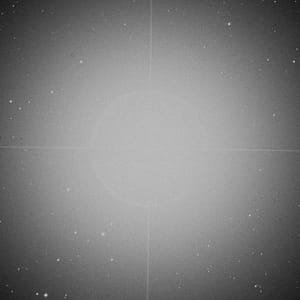
Milky Way Galaxy - Arcturus
Type of star: Red giant star (K1.5 IIIpe)
Apparent brightness: It is the 4th brightest star in the night sky, easily visible with the naked eye. It is a -0.04 quadrillion star.
Remoteness: It lies 36.7 light years from our solar system.
Color and warmth: It is orange-red in color. Its surface temperature is about 4290 K (about 4017 °C).
Size (radius and mass): It has about 25.4 times the radius of the Sun, but about the same mass as the Sun.
Age: It is about 7.1 billion years old.
Constellation: It is in the constellation of the Shepherd (Boötes).
Features:
- It is about 170 times brighter than the Sun.
- It is one of the oldest stars visible to the naked eye.
- It moves fast and follows a different orbit to other stars in the Milky Way.
Interesting information:
- It means "bear guard" in Greek.
- It can be easily found by following the handle of the Big Dipper. It is known by the mnemonic "Arc to Arcturus".
- In 1933, the light of Arcturus was used to open the Chicago World's Fair.
- It is an important star for some Native American tribes and is called the "Lord of the Sky".
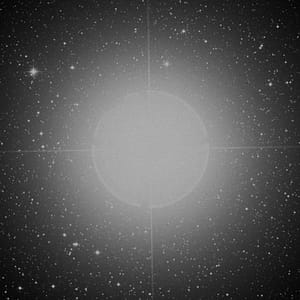
Milky Way Galaxy - Capella
Type of star: Quadruple star system (two double stars):
- Capella Aa: Yellow giant star (G8III)
- Capella Ab: Yellow giant star (G0III)
- Capella H: Red dwarf (M1V)
- Capella L: Red dwarf (M1V)
Apparent brightness: It is the 6th brightest star in the night sky, easily visible to the naked eye. It is a 0.08 quadrillion star (the total brightness of the system).
Remoteness: It lies 42.9 light years from our solar system.
Color and warmth: To the naked eye, it appears yellow. But because it is made up of different types of stars, each star has a different color and temperature:
- Capella Aa: Yellow, about 5700 K (about 5427 °C)
- Capella Ab: Yellow, about 5900 K (about 5627 °C)
Size (radius and mass):
- Capella Aa: It has about 11.98 times the Sun's radius and 2,568 times its mass.
- Capella Ab: It has about 8.83 times the radius and 2.482 times the mass of the Sun.
Age: It is about 590 million years old.
Constellation: It is in the constellation of the coachman (Auriga).
Features:
- It is a quadruple star system, made up of two double stars.
- To the naked eye it looks like a single star, but a telescope reveals that it is a double star.
Interesting information:
- It means "little female goat" in Latin.
- In Greek mythology, it is associated with Amalthea, the goat that suckled Zeus.
- In some cultures it is called the "Shepherd's Star".
- It can be seen prominently in the skies of the Northern Hemisphere during the winter months.

Milky Way Galaxy - Alderamin
Type of star: White giant star (A7IV-V)
Apparent brightness: It is the 30th brightest star in the night sky, easily visible to the naked eye. It is a 2.0 quadrillion star.
Remoteness: It is located about 48.8 light years from our solar system.
Color and warmth: It is white in color. Its surface temperature is about 7740 K (about 7467 °C).
Size (radius and mass): It has about 2.3 times the radius and 1.7 times the mass of the Sun.
Age: It is about 420 million years old.
Constellation: It is located in the constellation Cepheus (The King).
Features:
- It is a fast-rotating star and therefore bulges at the equator and flattens at the poles.
- About 18,000 years later, due to the precession of the Earth's axis, Alderamin will be the star closest to the North Pole, instead of the North Star (Polaris).
Interesting information:
- Derived from the Arabic phrase "al-dhirā' al-yamīn" meaning "right arm".
- Cepheus is the brightest star in the constellation Cepheus.
- It is considered one of the "Five Chariots" in Chinese mythology.
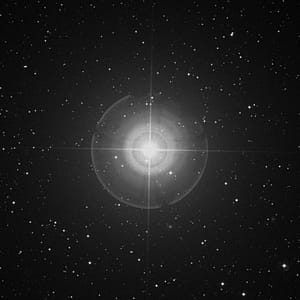
Milky Way Galaxy - Castor
Type of star: Six star system:
- Castor Aa: A-type anacole star (A1V)
- Castor Ab: Red dwarf (M5V)
- Castor Ba: A-type anacole star (A2Vm)
- Castor Bb: Red dwarf (M2V)
- Castor Ca: M-type anacole star (M0.5Ve)
- Castor Cb: M-type anacol star (M0.5Ve)
Apparent brightness: It is the 24th brightest star in the night sky, easily visible to the naked eye. It is a 1.93 quadrillion star (the total brightness of the system).
Remoteness: It is located 51 light years from our solar system.
Color and warmth: To the naked eye, it appears white. But because it is made up of different types of stars, each star has a different color and temperature:
- Castor Aa and Ba: White, about 10,000 K (about 9727 °C)
- Castor Ab and Bb: Red, about 3800 K (about 3527 °C)
- Castor Ca and Cb: Red, about 3800 K (about 3527 °C)
Size (radius and mass):
- Castor Aa: It has about 2.4 times the radius and 2.15 times the mass of the Sun.
- Castor Ba: It has about 1.9 times the radius and 1.71 times the mass of the Sun.
- Castor Ca ve Cb: Güneş’in yaklaşık %50’si yarıçapa ve %40’ı kütleye sahiptir.
Age: It is about 200 million years old.
Constellation: It is located in the constellation Gemini (Gemini).
Features:
- It is a system of six stars. The two main stars (Castor A and Castor B) are each spectroscopic double stars, and there is another double star, Castor C, orbiting these two pairs.
- To the naked eye it looks like a single star, but with a telescope it can be seen as a double star, and with more powerful telescopes it can be seen as a sextuple star system.
Interesting information:
- Castor and Pollux, the sons of Zeus and Leda in Greek mythology, are twin brothers. Castor is mortal and Pollux is immortal.
- It is one of the two brightest stars of Gemini (the other is Pollux).
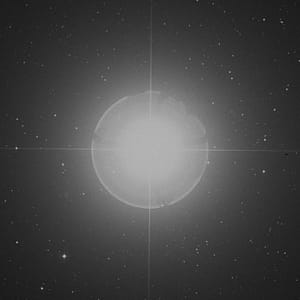
Milky Way Galaxy - Aldebaran
Type of star: Orange giant star (K5 III)
Apparent brightness: It is the 14th brightest star in the night sky, easily visible to the naked eye. It is a 0.87 quadrillion star.
Remoteness: It lies 65.23 light years from our solar system.
Color and warmth: It is orange-red in color. Its surface temperature is about 3910 K (about 3637 °C).
Size (radius and mass): It has about 44.2 times the radius and 1.16 times the mass of the Sun.
Age: It is about 6.4 billion years old.
Constellation: It is located in the constellation Taurus.
Features:
- It represents the eye of the bull.
- It is about 425 times brighter than the Sun.
- has a red dwarf companion from Kadir.
Interesting information:
- In Arabic, it means "one who follows". This is because it appears to follow the Pleiades star cluster in the sky.
- It is a star known since ancient times and has an important place in many cultures.
- In Persian mythology, it is one of the "Four Royal Stars".
- It is known as "Rohini" in India and has an important place in Hindu astrology.
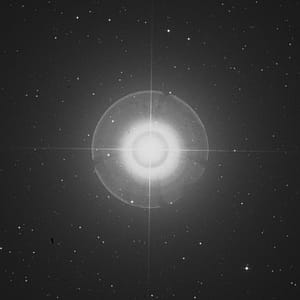
Milky Way Galaxy - Porter
Type of star: Orange giant star (K2 III)
Apparent brightness: It is the 48th brightest star in the night sky, easily visible to the naked eye. It is a 2.01 quadrillion star.
Remoteness: It lies 65.9 light years from our solar system.
Color and warmth: It is orange in color. Its surface temperature is about 4480 K (about 4207 °C).
Size (radius and mass): It has about 14 times the radius and 1.5 times the mass of the Sun.
Age: It is about 3.25 billion years old.
Constellation: It is located in the constellation Aries (Aries).
Features:
- It is the brightest star in the constellation Aries.
- It is about 91 times brighter than the Sun.
Interesting information:
- In Arabic it means "lamb" or "ram".
- It is a star known since ancient times and has an important place in many cultures.
- In Persian mythology, it is one of the "Four Royal Stars".
- It is a star thought to mark the beginning of the spring equinox.
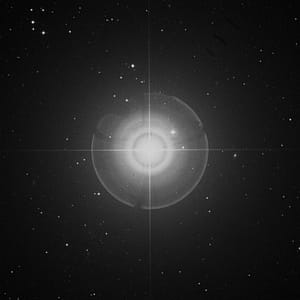
Milky Way Galaxy - Regulus
Type of star: The four star system:
- Regulus A:
- Regulus Aa: Bluish-white anacole star (B7V)
- Regulus Ab: Possibly white dwarf (not yet directly observed)
- Regulus B: Main arm star (K2V)
- Regulus C: Main arm star (M4V)
- Regulus D: (not yet verified)
Apparent brightness: It is the 21st brightest star in the night sky, easily visible to the naked eye. It is a 1.35 quadrillion star (the total brightness of the system).
Remoteness: It lies 79.3 light years from our solar system.
Color and warmth: To the naked eye, it appears bluish-white. But because it is made up of different types of stars, each star has a different color and temperature:
- Regulus Aa: Bluish white, about 12,000 K (about 11,727 °C)
- Regulus B: Orange, about 5,000 K (about 4,727 °C)
- Regulus C: Red, about 3,500 K (about 3,227 °C)
Size (radius and mass):
- Regulus Aa: It has about 3.5 times the radius and 3.8 times the mass of the Sun.
- Regulus B: Güneş’in yaklaşık %70’i kadar yarıçapa ve %80’i kadar kütleye sahiptir.
- Regulus C: Güneş’in yaklaşık %20’si kadar yarıçapa ve %30’u kadar kütleye sahiptir.
Age: It is about 1 billion years old.
Constellation: It is located in the constellation Leo (Leo).
Features:
- It is a quadruple star system, with the two main components (Regulus A and Regulus BC) closer and orbiting each other.
- Regulus A is a very fast-rotating star and therefore bulges at the equator and flattens at the poles.
- It represents the heart of the Lion.
Interesting information:
- In Latin it means "little king" or "prince".
- It is an important star, known since ancient times.
- In Persian mythology, it is one of the "Four Royal Stars".
- It is a star thought to mark the beginning of the spring equinox.

Milky Way Galaxy - Diphda
Type of star: Giant star (G9.5 III)
Apparent brightness: It is the 82nd brightest star in the night sky, easily visible to the naked eye. It is a 2.04 quadrillion star.
Remoteness: It is located 96.3 light years from our solar system.
Color and warmth: It is yellow-orange in color. Its surface temperature is about 5087 K (about 4814 °C).
Size (radius and mass): It has about 17 times the radius and 2.8 times the mass of the Sun.
Age: It is about 1 billion years old.
Constellation: It is in the constellation of the Whale (Cetus).
Features:
- It is the brightest star in the constellation of the Whale.
- It is about 145 times brighter than the Sun.
- It is a star that has used up the hydrogen in its core and is burning helium.
Interesting information:
- Derived from the Arabic phrase "Dhanab al-Qaiṭos al-Thānī", meaning "the second tail of the whale".
- In Chinese mythology, it is known as the "Gate of Heaven".
- It is an important star used by sailors for navigation.

Milky Way Galaxy - Sabik (Eta Ophiuchi)
Type of star: Double star system:
- Sabik A: White giant star (A1IV)
- Sabik B: White anacole star (A2V)
Apparent brightness: It is the 60th brightest star in the night sky, easily visible to the naked eye. It is a 2.43 quadrillion star (the total brightness of the system).
Remoteness: It lies 84.2 light years from our solar system.
Color and warmth: To the naked eye, it appears blue-white. But because it is made up of different types of stars, each star has a different color and temperature:
- Sabik A: White, about 9200 K (about 8927 °C)
- Sabik B: White, about 9000 K (about 8727 °C)
Size (radius and mass):
- Sabik A: It has about 6.8 times the radius and 5.5 times the mass of the Sun.
- Sabik B: It has about 2.5 times the radius and 2.0 times the mass of the Sun.
Age: It is about 300 million years old.
Constellation: It is in the constellation of the Serpent (Ophiuchus).
Features:
- It is a double star system. Two stars orbit each other for a period of 88 years.
- Both stars are rapidly rotating stars and therefore bulge at the equator and flatten at the poles.
Interesting information:
- In Arabic, it means "previous" or "foremost".
- It represents the head of the constellation of the Serpent.
- In Chinese mythology, it is known as the "Pillar of Heaven".
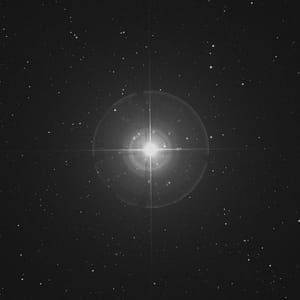
Milky Way Galaxy - Alpheratz
Type of star: Double star system:
- Alpheratz Aa: Mercury-Manganese star (B8IVpMnHg)
- Alpheratz B: Anacol star (A3V)
Apparent brightness: It is the 54th brightest star in the night sky, easily visible to the naked eye. It is a 2.06 quadrillion star.
Remoteness: It is located 97 light years from our solar system.
Color and warmth: It is bluish white in color. Its surface temperature is about 13,800 K (about 13,527 °C).
Size (radius and mass):
- Alpheratz Aa: It has about 3.6 times the radius and 3.8 times the mass of the Sun.
- Alpheratz B: It has about 1.8 times the radius and twice the mass of the Sun.
Age: It is about 60 million years old.
Constellation: It is located in the constellation Andromeda. It lies in a corner of the constellation Pegasus and is also part of Pegasus Square.
Features:
- It is a double star system.
- Alpheratz Aa is a star rich in mercury and manganese. Therefore, its spectrum shows strong streaks of these elements.
- It is a fast-rotating star and therefore bulges at the equator and flattens at the poles.
Interesting information:
- It is derived from the Arabic expression "al-surrat al-faras" meaning "the horse's belly".
- It is the brightest star in the constellation Andromeda.
- Some old maps show it as part of the constellation Pegasus.
- It is an important star traditionally used for navigation.
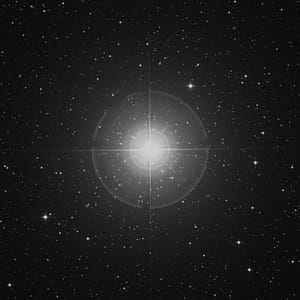
Milky Way Galaxy - Algol (Beta Persei)
Type of star: Triple star system: * Algol A: Bluish-white main star (B8V) * Algol B: Orange subgiant star (K0IV) * Algol C: Main star (A5V)
Apparent brightness: It is a variable star. It varies in brightness from 2.12 to 3.39 cadres and can be seen with the naked eye.
Remoteness: It is located 92.8 light years from our solar system.
Color and warmth: To the naked eye, it appears bluish-white, but its color can change as its brightness changes. Each star in the system has a different color and temperature: * Algol A: Bluish white, about 12,500 K (about 12,227 °C) * Algol B: Orange, about 4,800 K (about 4,527 °C) * Algol C: White, about 8,000 K (about 7,727 °C)
Size (radius and mass): * Algol A: It has about 3.5 times the radius and 3.6 times the mass of the Sun. * Algol B: About 3.7 times the radius and 1.7 times the mass of the Sun. * Algol C: About 1.7 times the radius and 1.6 times the mass of the Sun.
Age: It is about 300 million years old.
Constellation: It is located in the constellation Hero (Perseus).
Features:
- It is an obscured triple star system. Algol A and Algol B orbit very closely around each other, and Algol B periodically passes in front of Algol A, partially blocking its light. For this reason, Algol's brightness varies.
- It is the most well-known obscuring variable star and such stars are called "Algol-type variable stars".
- There is a situation known as the Algol paradox: Algol B has evolved into a more massive star than Algol A, but Algol A has more mass.
Interesting information:
- Derived from the Arabic phrase "ra's al-ghūl" meaning "the head of the devil".
- In ancient times it was considered an ominous star and was associated with the severed head of the Gorgon Medusa in Greek mythology.
- Changes in its brightness were noticed by ancient astronomers.
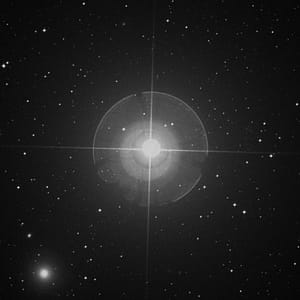
Milky Way Galaxy - Alnair (Alpha Gruis)
Type of star: Bluish-white subgiant star (B6 V-IV)
Apparent brightness: It is the 30th brightest star in the night sky, easily visible to the naked eye. It is a 1.73 quadrillion star.
Remoteness: It is located 101.37 light years from our solar system.
Color and warmth: It is bluish white in color. Its surface temperature is about 13,500 K (about 13,227 °C).
Size (radius and mass): It has about 4.5 times the radius and 5.1 times the mass of the Sun.
Age: It is about 100 million years old.
Constellation: It is in the constellation of the Crane (Grus).
Features:
- It is the brightest star in the constellation of the Crane.
- It is thought to be a double star, but it has not yet been conclusively proven.
- It is a fast-rotating star and therefore bulges at the equator and flattens at the poles.
Interesting information:
- It is derived from the Arabic word "al-nayyir" meaning "bright".
- It is a star in the southern hemisphere and can be seen from Turkey during the summer months.
- In Chinese mythology it is known as the "River of Heaven".
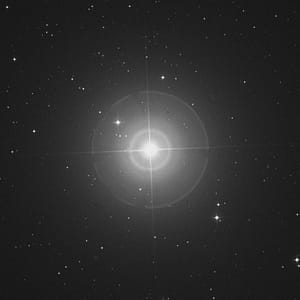
Milky Way Galaxy - Edasich (Iota Draconis)
Type of star: Orange giant star (K2 III)
Apparent brightness: It is easily visible to the naked eye in the night sky. It is a 3.29 quadrillion star.
Remoteness: It is located 101.2 light years from our solar system.
Color and warmth: It is orange in color. Its surface temperature is about 4545 K (about 4272 °C).
Size (radius and mass): It has about 12 times the radius and 1.82 times the mass of the Sun.
Age: It is about 1.15 billion years old.
Constellation: It is located in the constellation of the Dragon (Draco).
Features:
- A planet called Hypatia has been discovered in its neighborhood. This planet is about 8.8 times more massive than Jupiter.
- It is a star that has used up the hydrogen in its core and is burning helium.
Interesting information:
- It is derived from an Arabic word meaning "male hyena".
- It is one of the brightest stars in the constellation of the Dragon.
- In the northern hemisphere it can be seen throughout the year.

Milky Way Galaxy - Kochab (Beta Ursae Minoris)
Type of star: Orange giant star (K4 III)
Apparent brightness: It is the 57th brightest star in the night sky, easily visible to the naked eye. It is a 2.08 quadrillion star.
Remoteness: It is located 130.9 light years (or 126.41 light years according to some sources) from our solar system.
Color and warmth: It is orange in color. Its surface temperature is about 4,126 K (about 3,853 °C).
Size (radius and mass): It has about 42 times the radius and twice the mass of the Sun.
Age: It is about 2.95 billion years old.
Constellation: It is located in the constellation Ursa Minor.
Features:
- It is the second brightest star in the constellation of the Little Dipper (after Polaris).
- It is about 190 times brighter than the Sun.
- Beta hosts a confirmed exoplanet called Ursae Minoris b. This planet is at least 6 times more massive than Jupiter.
Interesting information:
- It is derived from the Arabic word "Al Kaukab" meaning "the star".
- Between 1500 BC and 500 AD, due to the rotation of the Earth's axis, the stars Kochab and Pherkad together assumed the role of the Pole Star. This is why they are also called the "Guardians of the Pole".
- It is an important star for some Native American tribes and is called the "Lord of the Sky".
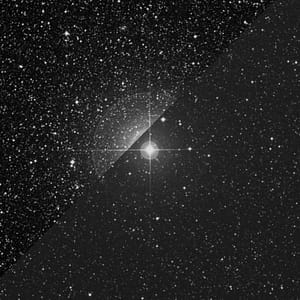
Milky Way Galaxy - Kaus Australis (Epsilon Sagittarii)
Type of star: Double star system:
- Kaus Australis A: Blue-white giant star (B9.5 III)
- Kaus Australis B: Unknown (not yet directly observed)
Apparent brightness: It is the brightest star in the constellation Sagittarius in the night sky, easily visible to the naked eye. It is a 1.85 quadrant star.
Remoteness: It is located 143 light years from our solar system.
Color and warmth: It is bluish white in color. Its surface temperature is about 11,200 K (about 10,927 °C).
Size (radius and mass):
- Kaus Australis A: It has about 5 times the radius and 5 times the mass of the Sun.
- Kaus Australis B: Unknown
Age: It is about 150 million years old.
Constellation: It is located in the constellation Sagittarius.
Features:
- It is one of the stars that make up the southern part of the "Teapot" asterism in the constellation Sagittarius.
- Its name, of Arabic origin, means "southern part of the arc".
- It is a fast-rotating star and therefore bulges at the equator and flattens at the poles.
Interesting information:
- In Chinese mythology, it is known as the "Gate of Heaven".
- To the naked eye it looks like a single star, but observations with large telescopes have shown that it is a double star.
- The star Kaus Australis B has not been directly observed, but its existence has been confirmed by spectroscopic analysis.

Milky Way Galaxy - Gienah (Gamma Corvi)
Type of star: Double star system:
- Gienah A: Blue-white giant star (B8III)
- Gienah B: Faint star (possibly white dwarf)
Apparent brightness: It is easily visible to the naked eye in the night sky. It is a 2.59 cadence star (the total brightness of the system).
Remoteness: It is located 165 light years from our solar system.
Color and warmth: It is bluish white in color. Its surface temperature is about 11,680 K (about 11,407 °C).
Size (radius and mass):
- Gienah A: It has about 4.2 times the radius and 4.2 times the mass of the Sun.
- Gienah B: Precise information is not available.
Age: It is about 160 million years old.
Constellation: It is in the constellation of the Crow (Corvus).
Features:
- It is the brightest star in the constellation of the Crow.
- It is a double star system, but its components are so close together that it is difficult to distinguish with a telescope.
- Gienah A is a rapidly rotating star and therefore bulges at the equator and flattens at the poles.
Interesting information:
- It is derived from the Arabic phrase "al-janāḥ al-ghirāb al-yaman" meaning "wing".
- In some astrological interpretations it is associated with luck and success.
- In some cultures it is also called the "Gate of Heaven".

Milky Way Galaxy - Peacock (Alpha Pavonis)
Type of star: Spectroscopic double star:
- Peacock A: Bluish-white subgiant star (B2 IV)
- Peacock B: A fainter star of unknown spectral type
Apparent brightness: It is the 43rd brightest star in the night sky, easily visible to the naked eye. It is a 1.91 cadence star (the total brightness of the system).
Remoteness: It is located 180 light years from our solar system.
Color and warmth: It is bluish white in color. Its surface temperature is about 22,400 K (about 22,127 °C).
Size (radius and mass):
- Peacock A: It has about 6 times the radius and 5.7 times the mass of the Sun.
- Peacock B: Precise information is not available.
Age: It is about 100 million years old.
Constellation: It is in the constellation of the Peacock (Pavo).
Features:
- It is the brightest star in the constellation Peacock.
- They are spectroscopic double stars, meaning that their components are so close together that they cannot be distinguished with a telescope.
- It is a fast-rotating star and therefore bulges at the equator and flattens at the poles.
Interesting information:
- It is named because it is the brightest star in the constellation Tavus (Pavo).
- In 1937, the name was adopted by "His Majesty's Nautical Almanac Office" published by the British Royal Navy.
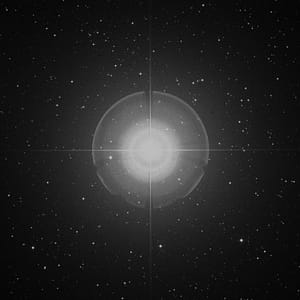
Milky Way Galaxy - Scheat (Beta Pegasi)
Type of star: Red giant star (M2.3 II-III)
Apparent brightness: It is easily visible to the naked eye in the night sky. It is a 2.42 quadrant star. However, it is a semi-regular variable star with a brightness ranging from 2.31 to 2.74 cadres.
Remoteness: It is 199 light years from our solar system.
Color and warmth: It is red-orange in color. Its surface temperature is about 3700 K (about 3427 °C).
Size (radius and mass): It has about 95 times the radius and 2.1 times the mass of the Sun.
Age: It is about 200 million years old.
Constellation: It is in the constellation of the Winged Horse (Pegasus).
Features:
- It forms a corner of the Great Square asterism that forms the body of the Winged Horse (Pegasus).
- It is a star that has used up the hydrogen in its core and is burning helium.
- It is a semi-regularly variable star, meaning that its brightness changes at irregular intervals.
Interesting information:
- It is derived from the Arabic word "as-sāq", meaning "leg" or "shin".
- In Chinese mythology, it is part of a constellation called "The Army".
- In some sources, the star's name is confused with "Markab".
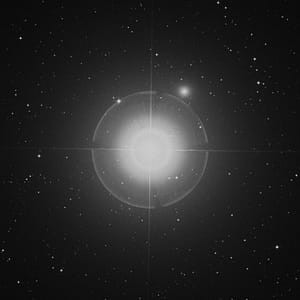
Milky Way Galaxy - Mirach (Beta Andromedae)
Type of star: Red giant star (M0 III)
Apparent brightness: It is easily visible to the naked eye in the night sky. It is a 2.06 quadrillion star.
Remoteness: It lies 197 light years from our solar system.
Color and warmth: It is red-orange in color. Its surface temperature is about 3842 K (about 3569 °C).
Size (radius and mass): It has about 80 times the radius and 3 times the mass of the Sun.
Age: It is about 300 million years old.
Constellation: It is located in the constellation Andromeda.
Features:
- Andromeda is one of the brightest stars in the constellation Andromeda.
- It is a star that has used up the hydrogen in its core and is burning helium.
- Mirach is thought to be associated with a nebula called Geist (ghost), but it is unclear whether this nebula is directly linked to Mirach.
Interesting information:
- It is derived from the Arabic word "mi'zar" meaning "sash".
- In the constellation Andromeda, it is a reference point used to find the path to the Andromeda Galaxy.
- In some sources, the star is also called "Mirak" or "Merak".
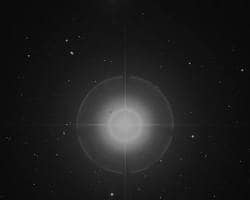
Milky Way Galaxy - Menkar (Alpha Ceti)
Type of star: Red giant star (M1.5IIIa)
Apparent brightness: It is easily visible to the naked eye in the night sky. It is a 2.54 quadrillion star.
Remoteness: It is located about 249 light years from our solar system.
Color and warmth: It is red-orange in color. Its surface temperature is about 3795 K (about 3522 °C).
Size (radius and mass): It has about 89 times the radius and 2.3 times the mass of the Sun.
Age: It is about 4 billion years old.
Constellation: It is in the constellation of the Whale (Cetus).
Features:
- It is the second brightest star in the constellation of the Whale (after Diphda).
- It is about 1455 times brighter than the Sun.
- It is a star that has used up the hydrogen in its core and is burning helium.
- It is a variable star, but its brightness changes are so small that they are not noticeable to the naked eye.
Interesting information:
- It is derived from the Arabic word "Menkhar" meaning "nostril".
- It was also called "Al Kaff al Jidhmah" (The Cut Hand) by ancient Arab astronomers.
- In Chinese mythology, it is known as "Tian Cang" (Heaven's Storehouse).
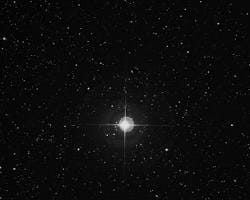
Milky Way Galaxy - Nunki (Sigma Sagittarii)
Type of star: Bluish-white main star (B2.5V)
Apparent brightness: It is the 49th brightest star in the night sky, easily visible to the naked eye. It is a 2.02 quadrillion star.
Remoteness: It is 224.21 light years from our solar system.
Color and warmth: It is bluish white in color. Its surface temperature is about 18,890 K (about 18,617 °C).
Size (radius and mass): It has about 4.5 times the radius and 7.8 times the mass of the Sun.
Age: It is about 31.4 million years old.
Constellation: It is located in the constellation Sagittarius.
Features:
- It is the star that forms the upper part of the handle of the "Teapot" asterism in the constellation Sagittarius.
- It is a rapidly rotating star and is significantly dilated in the equatorial region.
- Its spectrum shows strong lines of the element helium.
Interesting information:
- The name is of ancient Assyrian or Babylonian origin and its meaning is unknown.
- It is the second brightest star (after Kaus Australis) in the constellation Sagittarius.
- In some sources, the star is also called "Sadira" or "Pelagus".
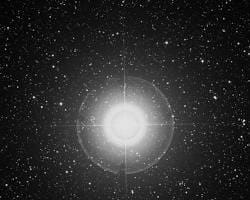
Milky Way Galaxy - Schedar (Alpha Cassiopeiae)
Type of star: Orange giant star (K0 IIIa)
Apparent brightness: It is easily visible in the night sky with the naked eye. It is the brightest star (or second brightest according to some sources) in the constellation of the Queen (Cassiopeia). It is a 2.24 quadrillion star.
Remoteness: It is located about 228 light years from our solar system.
Color and warmth: It is orange in color. Its surface temperature is about 4,530 K (about 4,257 °C).
Size (radius and mass): It has about 42 times the radius and 4-5 times the mass of the Sun.
Age: It is about 100-200 million years old. It is thought to have spent most of its time as a blue-white B-type anacole star.
Constellation: It is in the constellation of the Queen (Cassiopeia).
Features:
- It is the star in the center of the "W" shaped asterism of the Queen constellation.
- It is a star that has used up the hydrogen in its core and is burning helium.
- It is about 676 times brighter than the Sun.
Interesting information:
- It is derived from the Arabic word "shadr" meaning "chest".
- It is a star known since ancient times and has an important place in many cultures.
- In Chinese mythology it is known as "Wang Liang" and represents a charioteer.
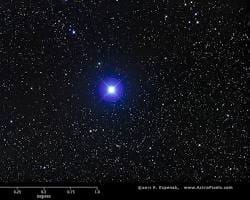
Milky Way Galaxy - Bellatrix (Gamma Orionis)
Type of star: Bluish white giant star (B2 III)
Apparent brightness: It is the 27th brightest star in the night sky, easily visible to the naked eye. It is a 1.64 quadrillion star.
Remoteness: It is located about 240 light years from our solar system.
Color and warmth: It is bluish white in color. Its surface temperature is about 21,500 K (about 21,227 °C).
Size (radius and mass): It has about 5.75 times the radius and 8.4 times the mass of the Sun.
Age: It is about 21.3 million years old.
Constellation: It is located in the constellation of the Hunter (Orion).
Features:
- It represents the left shoulder of the Hunter constellation.
- It is about 6400 times brighter than the Sun.
- It is a fast-rotating star and has expanded in the equatorial region.
Interesting information:
- It means "woman warrior" in Latin.
- Also known as "Al Najīd", which means "the giant" in Arabic.
- It was called "Al ʽUzza" by ancient Arab astronomers.

Milky Way Galaxy - Spica (Alpha Virginis)
Type of star: Spectroscopic double star:
- Spica A: Bluish white giant star (B1 III-IV)
- Spica B: Bluish-white anacole star (B2 V)
Apparent brightness: It is the 16th brightest star in the night sky, easily visible to the naked eye. It is a 0.98 cadence star. However, it is a Beta Cephei type variable star with a brightness ranging from 0.95 to 1.04 cadres.
Remoteness: It is located 260 light years from our solar system.
Color and warmth: It is bluish white in color. The surface temperature is around 22,400 K (Spica A) and 18,500 K (Spica B).
Size (radius and mass):
- Spica A: It has about 7.4 times the radius and 11 times the mass of the Sun.
- Spica B: It has about 3.6 times the radius and 7 times the mass of the Sun.
Age: It is about 12.5 million years old.
Constellation: It is located in the constellation Virgo.
Features:
- It is the brightest star in the constellation Virgo.
- They are spectroscopic double stars, meaning that their components are so close together that they cannot be distinguished with a telescope.
- Both stars are rapidly rotating stars and therefore bulge at the equator and flatten at the poles.
- Beta Cephei is a type variable star, meaning that its brightness changes slightly on a regular basis.
Interesting information:
- It means "spike" in Latin and represents the ear of wheat held by the constellation Virgo.
- In ancient Greece, Spica was thought to mark the beginning of the vernal equinox.
- In some cultures, Spica is associated with Demeter, the goddess of fertility.

Milky Way Galaxy - Sargas (Theta Scorpii)
Type of star: Double star system:
- Sargas A: Yellow-white bright giant star (F1 II)
- Sargas B: A fainter star with unknown spectral type
Apparent brightness: It is the 39th brightest star in the night sky, easily visible to the naked eye. It is a 1.87 quadrillion star.
Remoteness: It is located about 272 light years from our solar system.
Color and warmth: It is yellow-white in color. Its surface temperature is about 7,200 K (about 6,927 °C).
Size (radius and mass):
- Sargas A: It has about 26 times the radius and 10 times the mass of the Sun.
- Sargas B: Precise information is not available.
Age: It is about 11 million years old.
Constellation: It is in the constellation Scorpio (Scorpius).
Features:
- It is the third brightest star in the constellation Scorpio.
- It is a double star system.
- Sargas A is a rapidly rotating star and therefore bulges at the equator and flattens at the poles.
Interesting information:
- The name is of Sumerian origin and its meaning is unknown.
- It is a star in the southern hemisphere and is observed at low altitude in northern latitudes.
- Some sources refer to the star as "Theta Scorpii" instead of "Sargas".
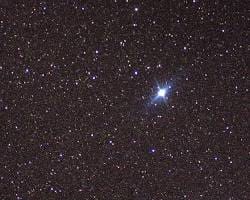
Milky Way Galaxy - Canopus (Alpha Carinae)
Type of star: White-yellow supergiant star (F0 Ia)
Apparent brightness: It is the second brightest star in the night sky, easily visible to the naked eye. It is a -0.72 quadrillion star.
Remoteness: It is located 309 light years from our solar system.
Color and warmth: It is white-yellow in color. Its surface temperature is about 7,350 K (about 7,077 °C).
Size (radius and mass): It has about 65 times the radius and 8-9 times the mass of the Sun.
Age: It is about 30 million years old.
Constellation: It is located in the constellation Carina (Carina).
Features:
- It is the brightest star in the constellation Carina.
- It is about 15,000 times brighter than the Sun.
- Helium fusion takes place at its core.
Interesting information:
- In Greek mythology, it is named after Canopus, the captain of the Argo, the ship of Menelaus, King of Sparta.
- In some ancient cultures it was used as an important star for navigation.
- It is an important star for observers in the southern hemisphere and is often used as a reference point for navigation.

Milky Way Galaxy - Polaris Australis (Sigma Octantis)
Type of star: Yellow-white giant star (F0 III)
Apparent brightness: It is barely visible to the naked eye in the night sky. It is a 5.47 quadrillion star.
Remoteness: It is located about 280 light years from our solar system.
Color and warmth: It is yellow-white in color. Its surface temperature is about 7246 K (about 6973 °C).
Size (radius and mass): It has about 2.6 times the radius and twice the mass of the Sun.
Age: It is about 294 million years old.
Constellation: It is in the constellation of the Octans.
Features:
- It is the closest star to the south celestial pole, but it is not as bright as Polaris (the North Star), so it is difficult to see with the naked eye.
- It is a variable star, classified as a Delta Scuti type. Its brightness varies by 0.03 cadence with a period of 2.3 hours.
Interesting information:
- The name "Polaris Australis" means "Pole Star of the South" in Latin.
- It is a reference point used for navigation in the southern hemisphere, but it is more difficult to use because it is not as bright as Polaris.
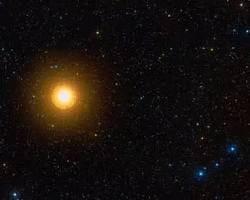
Milky Way Galaxy - Almach (Gamma Andromedae)
Type of star: The four star system:
- Almach A (Gamma1 Andromedae): Orange bright giant star (K3 IIb)
- Almach B (Gamma2 Andromedae): Bluish-white anacole star (B9.5 V)
- Almach C (Gamma2 Andromedae B): Faint blue anacole star (A0 V)
- Almach D (Gamma2 Andromedae C): Faint blue anacole star (A0 V)
Apparent brightness: To the naked eye it looks like a single star, but it is actually a system of four stars. Its total apparent brightness is 2.10 cadres.
Remoteness: It is located about 350 light years from our solar system.
Color and warmth: Almach A glows orange, while Almach B is bluish-white.
- Almach A: Approx. 4,500 K (approx. 4,227 °C)
- Almach B: About 10,000 K (about 9,727 °C)
Size (radius and mass):
- Almach A: It has about 80 times the radius and 4 times the mass of the Sun.
- Almach B: It has about 2.7 times the radius and 3.3 times the mass of the Sun.
Age: It is about 350 million years old.
Constellation: It is located in the constellation Andromeda.
Features:
- It is a quadruple star system. Almach A and Almach B orbit each other for a period of 63.7 years. Almach B itself is a double star, consisting of two stars, Almach C and Almach D.
- Almach A is a star nearing the end of its life and will eventually turn into a white dwarf.
Interesting information:
- Almach means "lynx" or "desert lynx" in Arabic.
- To the naked eye, it appears as an eye-catching double star with orange and blue color contrast.
- It is a popular target for amateur astronomers.
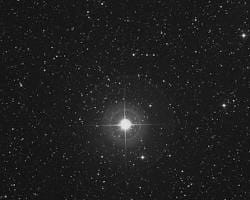
Milky Way Galaxy - Sulaphat (Gamma Lyrae)
Type of star: Bluish white giant star (B9 III)
Apparent brightness: It is easily visible to the naked eye in the night sky. It is a 3.24 quadrillion star.
Remoteness: It is located about 620 light years from our solar system.
Color and warmth: It is bluish white in color. Its surface temperature is about 10,000 K (about 9,727 °C).
Size (radius and mass): It has about 15 times the radius and 5.7 times the mass of the Sun.
Age: It is about 100 million years old.
Constellation: It is in the constellation of the instrument (Lyra).
Features:
- It is the second brightest star in the constellation Instrument (after Vega).
- It is a fast-rotating star and therefore bulges at the equator and flattens at the poles.
- Although some sources list it as a spectroscopic double star, it is now thought to be a single star.
Interesting information:
- It is derived from the Arabic word "al-sulḥafāt" meaning "the turtle". This name refers to the mythological origin of the constellation Instrument.
- Along with other bright stars in the constellation of the instrument, it represents the instrument of the mythological bard Orpheus.
- In the northern hemisphere, it can be easily seen in the summer sky.
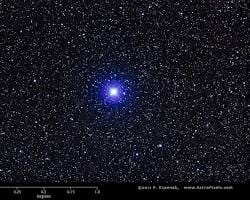
Milky Way Galaxy Simulation - Adhara (Epsilon Canis Majoris)
Type of star: Binary star system:
- Adhara A: Bluish-white giant star (B2 II)
- Adhara B: Bluish-white anacole star (B2 V)
Apparent brightness: It is the 22nd brightest star in the night sky, easily visible to the naked eye. It is a 1.50 quadrillion star.
Remoteness: It is located about 430 light years from our solar system.
Color and warmth: It is bluish-white in color. Its surface temperature is about 25,000 K (about 24,727 °C).
Size (radius and mass):
- Adhara A: It has about 12.4 times the radius and 11.8 times the mass of the Sun.
- Adhara B: It has about 7.5 times the radius and 8.7 times the mass of the Sun.
Age: It is about 22.5 million years old.
Constellation: It is in the constellation of the Big Dog (Canis Major).
Features:
- It is the second brightest star (after Sirius) in the constellation Big Dog.
- It is a binary star system, but its components are so close together that it is difficult to distinguish with a telescope.
- Both stars are rapidly rotating stars and therefore bulge at the equator and flatten at the poles.
Interesting information:
- It is derived from the Arabic word "al-ʿaðārā" meaning "virgins".
- About 4.7 million years ago, it was the brightest star in the sky because it was much closer to the Sun.
- In some cultures it is known as the "River of Heaven".

Milky Way Galaxy - Polaris (North Star)
Type of star: Triple star system:
- Polaris Aa: Yellow supergiant star (F7Ib-II)
- Polaris Ab: Main arm star (F6V)
- Polaris B: Main arm star (F3V)
Apparent brightness: It is the 48th brightest star in the night sky, easily visible to the naked eye. It is a 1.97 quadrillion star.
Remoteness: It is located about 433 light years from our solar system.
Color and warmth: It is yellow in color. Its surface temperature is about 6015 K (about 5742 °C).
Size (radius and mass):
- Polaris Aa: It has about 46 times the radius and 5.4 times the mass of the Sun.
- Polaris Ab: It has about 1.5 times the radius and 1.26 times the mass of the Sun.
- Polaris B: It has about 1.39 times the radius and 1.39 times the mass of the Sun.
Age: It is about 70 million years old.
Constellation: It is located in the constellation Ursa Minor.
Features:
- It is known as the North Star because it is the star closest to the north celestial pole.
- The Cepheid variable is a star, which means that its brightness changes regularly. However, the brightness variations are quite small (0.03 quadrillion) and difficult to detect with the naked eye.
Interesting information:
- Polaris does not actually correspond exactly to the celestial pole. However, because its position relative to other stars remains almost constant, it has been used as an important reference point for navigation.
- Due to the precession of the Earth's axis, Polaris will no longer be the star closest to the north celestial pole after about 25,770 years and will be replaced by another star.
- In Greek mythology, she is associated with Phoenice, daughter of Phoenician King Agenor and sister of Kadmos.

Milky Way Galaxy - Antares (Alpha Scorpii)
Type of star: Binary star system:
- Antares A: Red supergiant star (M1.5Iab-Ib)
- Antares B: Bluish-white anacole star (B2.5V)
Apparent brightness: It is the 15th brightest star in the night sky, easily visible to the naked eye. It is a star of 0.96 cadres on average, but because it is a semi-regular variable, its brightness can vary between 0.6 and 1.6 cadres.
Remoteness: It is located about 550 light years from our solar system.
Color and warmth: It glows red. Its surface temperature is about 3,400 K (about 3,127 °C).
Size (radius and mass):
- Antares A: It has about 883 times the radius and 12 times the mass of the Sun.
- Antares B: It has about 7 times the radius and 10 times the mass of the Sun.
Age: It is about 11 million years old.
Constellation: It is in the constellation Scorpio (Scorpius).
Features:
- It is considered the brightest star and the "heart" of the constellation Scorpio.
- It is a binary star system.
- Antares A is a star nearing the end of its life and is expected to be destroyed by a supernova explosion in a few million years.
Interesting information:
- Its name means "rival to Mars" or "similar to Mars" in Greek. This is due to the star's red color resembling the color of the planet Mars.
- It was an important star in ancient Egypt and some temples were oriented according to Antares.
- In Chinese mythology, it is known as the "Fire Star".

Milky Way Galaxy - Mirfak (Alpha Persei)
Type of star: White-yellow supergiant star (F5 Ib)
Apparent brightness: It is the 35th brightest star in the night sky, easily visible to the naked eye. It is a 1.79 quadrillion star.
Remoteness: It is located about 590 light years from our solar system.
Color and warmth: It is white-yellow in color. Its surface temperature is about 6,180 K (about 5,907 °C).
Size (radius and mass): It has about 62 times the radius and 8-11 times the mass of the Sun.
Age: It is about 50 million years old.
Constellation: It is located in the constellation Hero (Perseus).
Features:
- It is the brightest star in the constellation Hero.
- It lies at the center of an open star cluster known as the Alpha Persei Cluster.
- It is about 5,000 times brighter than the Sun.
- It is a star that has used up the hydrogen in its core and is burning helium.
Interesting information:
- It means "elbow" in Arabic and represents the Hero's elbow.
- In Chinese mythology, it is known as the "Role Star".
- It is an important star for some Native American tribes and is called the "Lord of the Sky".
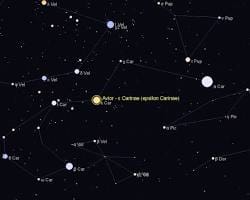
Milky Way Galaxy - Avior (Epsilon Carinae)
Type of star: Binary star system:
- Avior A: Orange bright giant star (K3 III)
- Avior B: A fainter star with unknown spectral type
Apparent brightness: It is the 36th brightest star in the night sky, easily visible to the naked eye. It is a 1.86 quadrillion star.
Remoteness: It is located about 630 light years from our solar system.
Color and warmth: It glows orange. Its surface temperature is about 4,100 K (about 3,827 °C).
Size (radius and mass):
- Avior A: It has about 140 times the radius and 10 times the mass of the Sun.
- Avior B: Precise information is not available.
Age: It is about 37.8 million years old.
Constellation: It is located in the constellation Carina (Carina).
Features:
- It is the third brightest star in the constellation Carina (after Canopus and Miaplacidus).
- It is a double star system, but its components are so close together that it is difficult to distinguish with a telescope.
- Avior A is a slowly changing star and can vary in brightness by as much as 0.1 quadrants.
Interesting information:
- The name was used in "The Air Almanac", an air navigation almanac published by the British Royal Navy in the 1930s.
- Although the exact origin of Avior is unknown, some sources suggest that it may be derived from the Hebrew word "avi" meaning "father".
- It is a star in the southern hemisphere and is observed at low altitude in northern latitudes.
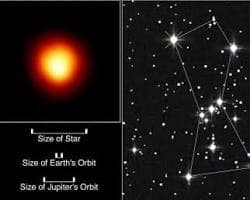
Milky Way Galaxy - Betelgeuse (Alpha Orionis)
Type of star: Red supergiant star (M1-2 Ia-ab)
Apparent brightness: It is the 9th or 10th brightest star in the night sky, easily visible to the naked eye. It is a semi-regular variable star, ranging from 0.42 to 1.3 quadrants.
Remoteness: It is located about 642.5 light-years from our solar system (according to the latest measurements).
Color and warmth: It is red-orange in color. Its surface temperature is about 3,600 K (about 3,327 °C).
Size (radius and mass): It is estimated to have about 764 to 1021 times the radius and 16.5-19 times the mass of the Sun.
Age: It is about 8-8.5 million years old.
Constellation: It is located in the constellation of the Hunter (Orion).
Features:
- It represents the right shoulder (or left shoulder as seen from Earth) of the constellation of the Hunter.
- It is about 100,000 times brighter than the Sun.
- It is a star that has used up the hydrogen in its core and is burning helium.
- It is an extremely large star, and if it were the Sun, its surface would extend almost as far as the orbit of Jupiter.
Interesting information:
- It is derived from the Arabic phrase "yad al-jawzā'" meaning "the hand of al-jawzā'" or "the middle part".
- Betelgeuse is a star nearing the end of its life and is expected to be destroyed in the near future (on an astronomical scale) by a supernova explosion. This explosion could be bright enough to be visible from Earth even during daytime.
- In 2019-2020, Betelgeuse unexpectedly lost its brightness, raising the possibility of a supernova explosion. However, it later recovered and its brightness returned to normal.
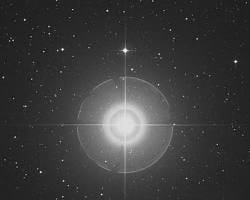
Milky Way Galaxy - Saiph (Kappa Orionis)
Type of star: Bluish-white supergiant star (B0.5 Ia)
Apparent brightness: It is easily visible to the naked eye in the night sky. It is the sixth brightest star in the constellation of the Hunter (Orion). It is a 2.07 magnitude star.
Remoteness: It is located about 724 light years from our solar system.
Color and warmth: It is bluish-white in color. Its surface temperature is about 26,500 K (about 26,227 °C).
Size (radius and mass): It has about 11 times the radius and 15.5 times the mass of the Sun.
Age: It is about 11 million years old.
Constellation: It is located in the constellation of the Hunter (Orion).
Features:
- It represents the right foot (or left foot as seen from Earth) of the constellation of the Hunter.
- It is about 65,000 times brighter than the Sun.
- It is a fast-rotating star and has expanded in the equatorial region.
Interesting information:
- It is derived from the Arabic phrase "saif al jabbar" meaning "sword".
- Although it is a very young star, it is aging rapidly due to its large mass and is nearing the end of its life.
- It is expected to be destroyed by a supernova explosion in a few million years.
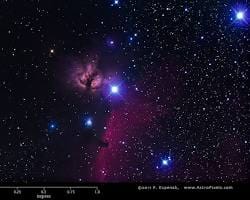
Milky Way Galaxy - Alnitak (Zeta Orionis)
Type of star: Triple star system:
- Alnitak Aa: Bluish-white supergiant star (O9.5 Iab)
- Alnitak Ab: Bluish-white anacole star (B0 III)
- Alnitak B: Bluish-white anacole star (B1 IV)
Apparent brightness: It is the 31st brightest star in the night sky, easily visible to the naked eye. It is a 1.74 cadence star (the total brightness of the system).
Remoteness: It is located about 1,260 light-years from our solar system.
Color and warmth: It is bluish-white in color. Its surface temperature is about 31,000 K (about 30,727 °C).
Size (radius and mass):
- Alnitak Aa: It has about 20 times the radius and 28 times the mass of the Sun.
- Alnitak Ab: It has about 14 times the radius and 14 times the mass of the Sun.
- Alnitak B: It has about 7.3 times the radius and 16 times the mass of the Sun.
Age: It is about 6 million years old.
Constellation: It is located in the constellation of the Hunter (Orion).
Features:
- It is the easternmost of the three stars (Alnitak, Alnilam, Mintaka) that make up the Hunter's Belt.
- It is a triple star system. Alnitak Aa and Ab are very close to each other, while Alnitak B is farther away.
- Alnitak Aa is a very massive and hot star. It is nearing the end of its life and is expected to be destroyed in a supernova explosion.
- It is associated with an emission nebula called IC 434.
Interesting information:
- In Arabic it means "belt" or "girdle".
- Alnitak is the brightest star in the Hunter Belt.
- It is one of the most important and easily recognizable stars in the constellation Orion.
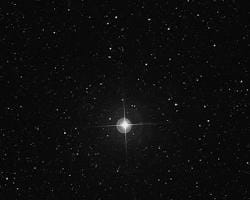
Milky Way Galaxy - Aspidiske (Iota Carinae)
Type of star: White bright supergiant star (A8 Ib)
Apparent brightness: It is easily visible to the naked eye in the night sky. It is a 2.21 quadrillion star.
Remoteness: It is located 690 light years from our solar system.
Color and warmth: It is white in color. Its surface temperature is about 7,500 K (about 7,227 °C).
Size (radius and mass): It has about 40 times the radius and 7.4 times the mass of the Sun.
Age: It is about 40 million years old.
Constellation: It is located in the constellation Carina (Carina).
Features:
- It is the fourth brightest star in the constellation Carina (after Canopus, Miaplacidus and Avior).
- It is about 4,900 times brighter than the Sun.
- It is a star that has used up the hydrogen in its core and is burning helium.
- It is a variable star, but its brightness changes are so small that they are not noticeable to the naked eye.
Interesting information:
- It is derived from the Greek word "aspidiske" meaning "small shield".
- Other traditional names include Turais and Scutulum.
- It is a star in the southern hemisphere and is observed at low altitude in northern latitudes.
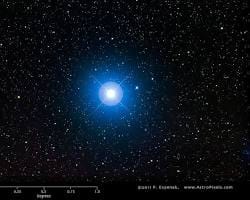
Milky Way Galaxy - Rigel (Beta Orionis)
Type of star: Multiple star system:
- Rigel A: Bluish-white supergiant star (B8Ia)
- Rigel B: Spectroscopic double star system
- Rigel Ba: Main arm star (B9V)
- Rigel Bb: Main arm star (B9V)
- Rigel C: A possible fourth component not confirmed by imaging
Apparent brightness: It is the 7th brightest star in the night sky, easily visible to the naked eye. It is a 0.12 quadrillion star (the total brightness of the system).
Remoteness: It is located about 863 light years from our solar system.
Color and warmth: It glows bluish-white. Its surface temperature is about 12,100 K (about 11,827 °C).
Size (radius and mass):
- Rigel A: It has about 78.9 times the radius and 21 times the mass of the Sun.
- Rigel Ba and Bb: They have a radius and mass several times that of the Sun (exact values unknown).
Age: It is about 8 million years old.
Constellation: It is located in the constellation of the Hunter (Orion).
Features:
- It represents the right foot (or left foot as seen from Earth) of the constellation of the Hunter.
- It is about 120,000 times brighter than the Sun.
- Although it is a very young star, it is aging rapidly due to its large mass and is nearing the end of its life.
- It is expected to be destroyed by a supernova explosion in a few million years.
Interesting information:
- It is derived from the Arabic phrase "Rijl Jauzah al Yusrā", meaning "The Foot of the Middle" (of the constellation of the Hunter).
- It lies diagonally across the three stars (Alnitak, Alnilam, Mintaka) that make up the Hunter's Belt.
- Mythologically, Orion's hunting dog Sirius is thought to have crushed Lepus, the rabbit he was hunting.
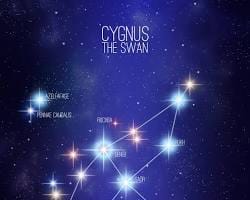
Milky Way Galaxy - Rukh (Deneb)
Type of star: White supergiant star (A2Ia)
Apparent brightness: It is the 19th brightest star in the night sky, easily visible to the naked eye. It is a 1.25 quadrillion star.
Remoteness: Its distance to our solar system is not known for certain. It is estimated to be between 1,550 and 2,600 light years away.
Color and warmth: It is white in color. The surface temperature is about 8,525 K (about 8,252 °C).
Size (radius and mass): It has about 203 times the radius and 19-25 times the mass of the Sun.
Age: It is about 10 million years old.
Constellation: It is located in the constellation Cygnus (Cygnus).
Features:
- It is the brightest star in the constellation of the Swan and is also known by the name Deneb, meaning "tail".
- It is one of the three bright stars that make up the Summer Triangle (the others are Vega and Altair).
- It is about 200,000 times brighter than the Sun.
- It is a fast-rotating star and has expanded in the equatorial region.
Interesting information:
- The name "Rukh" comes from the giant bird Rukh in Arab mythology.
- Deneb's extreme brightness makes it easily visible to the naked eye in the night sky.
- Deneb is a star nearing the end of its life and is expected to be destroyed by a supernova explosion in a few million years.
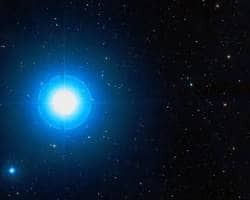
Milky Way Galaxy - Markab (Alpha Pegasi)
Type of star: B9 is a class V blue-white main-sequence star, but is also classified as B9 III (giant star) in some sources.
Apparent brightness: It is easily visible to the naked eye in the night sky. It is a 2.49 quadrillion star.
Remoteness: It is located 139 light years from our solar system.
Color and warmth: It is bluish white in color. Its surface temperature is about 11,100 K (about 10,827 °C).
Size (radius and mass): It has about 4.3 times the radius and 4.5 times the mass of the Sun.
Age: It is about 205 million years old.
Constellation: It is in the constellation of the Winged Horse (Pegasus).
Features:
- It forms a corner of the Great Square asterism that forms the body of the Winged Horse (Pegasus).
- It began to consume the hydrogen in its core and slowly began to transform into a red giant.
- It is a fast-rotating star and therefore bulges at the equator and flattens at the poles.
Interesting information:
- It is derived from the Arabic word "markab" meaning "saddle" or "mount".
- In Chinese mythology it is known as "Shih" and represents a corpse.
- It is an important star used for navigation.
- Some sources refer to the star as "Alpha Pegasi" instead of "Markab".
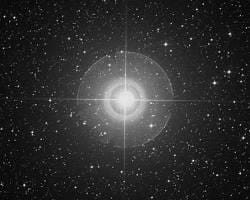
Milky Way Galaxy - Wezen (Delta Canis Majoris)
Type of star: Yellow-white F-type supergiant star (F8 Ia)
Apparent brightness: It is easily visible to the naked eye in the night sky. It is a 1.83 magnitude star. It is the third brightest star in the constellation Canis Major.
Remoteness: It is located about 1,800 light years from our solar system.
Color and warmth: It is yellow-white in color. Its surface temperature is about 6,200 K (about 5,927 °C).
Size (radius and mass): It has about 200 times the radius and 17 times the mass of the Sun.
Age: It is about 10 million years old.
Constellation: It is in the constellation of the Big Dog (Canis Major).
Features:
- It is one of the brightest stars in the constellation Big Dog.
- It is about 50,000 times brighter than the Sun.
- It is a star that has used up the hydrogen in its core and is burning helium.
- It is nearing the end of its lifetime and is expected to be destroyed by a supernova explosion in a few million years.
Interesting information:
- It is derived from the Arabic word "al-wazn" meaning "weight".
- According to some sources, the name was given because the star appeared low on the horizon.
- It was an important star in ancient Egypt and some temples were oriented according to Wezen.
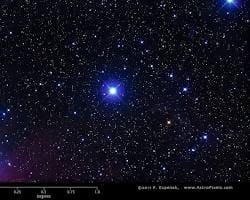
Milky Way Galaxy - Alnilam (Epsilon Orionis)
Type of star: Bluish-white supergiant star (B0 Ia)
Apparent brightness: It is the 29th brightest star in the night sky, easily visible to the naked eye. It is a 1.69 magnitude star. It is the brightest of the three stars in the Hunter's Belt (Alnitak, Alnilam, Mintaka).
Remoteness: It is located about 2,000 light years from our solar system.
Color and warmth: It is bluish-white in color. Its surface temperature is about 27,500 K (about 27,227 °C).
Size (radius and mass): It has about 30 times the radius and 40 times the mass of the Sun.
Age: It is about 4 million years old.
Constellation: It is located in the constellation of the Hunter (Orion).
Features:
- It is the star in the center of the Hunter's Belt.
- It is about 375,000 times brighter than the Sun.
- It is a fast-rotating star and emits a strong stellar wind.
- It is a star that has used up the hydrogen in its core and is burning helium.
Interesting information:
- It means "string of pearls" in Arabic.
- In ancient Egypt, Alnilam and other Hunter's Belt stars were considered the belt of Osiris.
- Alnilam is a star nearing the end of its life and is expected to be destroyed by a supernova explosion in a few million years.

Milky Way Galaxy - Deneb (Alpha Cygni)
Type of star: White supergiant star (A2Ia)
Apparent brightness: It is the 19th brightest star in the night sky, easily visible to the naked eye. It is a 1.25 quadrillion star.
Remoteness: Its distance to our solar system is not known with certainty and measurements made by different methods give different results. It is estimated to be between 1,400 and 3,550 light years.
Color and warmth: It is white in color. The surface temperature is about 8,525 K (about 8,252 °C).
Size (radius and mass): It has about 203 times the radius and 19-25 times the mass of the Sun.
Age: It is about 10 million years old.
Constellation: It is located in the constellation Cygnus (Cygnus).
Features:
- It is the brightest star in the constellation of the Swan and is also known by the name Deneb, meaning "tail".
- It is one of the three bright stars that make up the Summer Triangle (the others are Vega and Altair).
- It is about 196,000 times brighter than the Sun.
- It is a fast-rotating star and has expanded in the equatorial region.
- Alpha Cygni is a type of star classified as variable, meaning that its brightness and spectrum vary slightly.
Interesting information:
- The name "Deneb" is derived from the Arabic word "dhaneb" meaning "tail".
- Deneb is one of the brightest known stars and is also the most distant first-quadrant star.
- Deneb's extreme brightness makes it easily visible to the naked eye in the night sky.
- Deneb is a star nearing the end of its life and is expected to be destroyed by a supernova explosion in a few million years.
